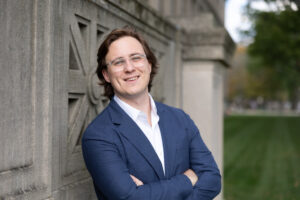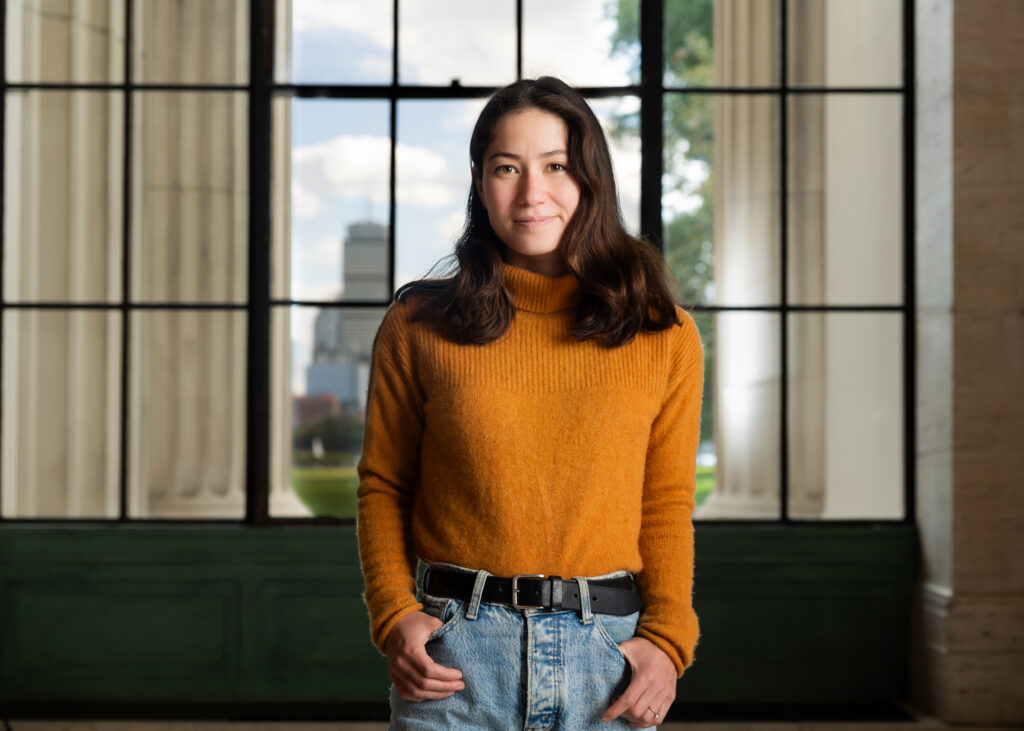Making math work
MathWorks Fellows Davis Evans and Elena Kim study the next big things with mathematics

MathWorks Fellow Davis Evans. Photo: Steph Stevens
MATLAB, a widely-used software program, is the signature product and most renowned creation of MathWorks, a company founded by John N. Little ’78 and Cleve Moler. Designed for scientists and engineers, MATLAB is a programming environment that enables users to combine mathematics, graphics, and coding to develop algorithms, perform computations, and generate simulations for research. Faculty, students, and researchers across MIT extensively use the software — as do more than four million users in industry, government, and academia in 185 countries. A complimentary program, Simulink, MathWorks’ graphic modeling and simulation program, is also well-known.
“Our tagline is: ‘Accelerating the pace of engineering and science,’” says Little, president of MathWorks. “That’s what we’re about and what we do. We have a strong belief in the importance of engineers and scientists. They act to increase human knowledge and profoundly improve our standard of living. We created products like MATLAB and Simulink to help them do their best work.”
Two students, Davis Evans and Elena Kim were recently named MathWorks Fellows.
Davis Evans
With Davis Evans’ applied mathematics background, he can work on everything from brains to semiconductors to fluid dynamics, all with the help of MATLAB software.
MATLAB has been a core element of Evans’ workflow for 10 years since he used it at an internship modeling helicopter dampers. Evans studied engineering science at Penn State, where, in an interdisciplinary program, he researched mathematical models of injury-induced pressure waves in the brain.
“The differential equations that describe the motion of these droplets usually can’t be solved with pen and paper: that’s where MATLAB comes in”
Davis Evans
After graduation, he worked in industry for a few years, working on vibration and servo control schemes for state-of-the-art machines that print computer chips at a company called ASML.
“The technology at ASML is very impressive – they are basically keeping Moore’s Law alive,” says Evans. “I learned a lot there and was very thankful to contribute to such an effort.”
But he decided to move over to mathematics when he came to MIT. “I found that applied mathematics is a very powerful way to communicate across technical disciplines.”
He was excited to work on hydrodynamic quantum analogues in Professor John Bush’s lab. Evans runs experiments where a droplet of silicone oil is made to bounce on the surface of a vibrating bath.
These experiments with droplets create a visual analogy for what might be happening with electrons, which are much harder to visualize.
“The differential equations that describe the motion of these droplets usually can’t be solved with pen and paper: that’s where MATLAB comes in,” says Evans. “We also need it to analyze the data that come from our experiments.”
The bounces set down waves, from which the droplet is propelled around the bath. He also develops dynamical models of these bouncing droplets, and studies to what extent they resemble quantum systems.
“I have always been fond of physical analogues, where two systems are described by the same governing equations,” he says. “To have a macroscopic system with particle-wave duality, poses some very deep and exciting questions about quantum mechanics.”
After graduation he’s looking forward to teaching and research. But while he’s at MIT, he enjoys learning to sail, and hiking in the White Mountains in New Hampshire. He plays the organ and other keyboard instruments, and recently ran the MIT Math IAP music concert, where he most recently performed on the harpsicord.

MathWorks Fellow Elena Kim. Photo: Steph Stevens
Elena Kim
Elena Kim is a third-year PhD student in the MIT Department of Mathematics, where she is studying semiclassical measures for quantum cat maps.
Quantum cat maps are toy models in the field of quantum chaos, and semiclassical measures help quantify the limit behavior of their eigenfunctions. Her goal is to prove characteristics of the support of semiclassical measures. She uses MATLAB to create pictures illustrating the support of the semiclassical measures, helping inform conjectures.
Kim is originally from Greenwich, Connecticut. She completed her undergraduate at Pomona College, majoring in mathematics. In her free time, she likes going on bike rides. Otherwise, she just enjoys spending as much time as possible outdoors.
Since spring 2023, she has worked as a tutor for the Boston Pre-Release Center, a minimum and pre-release correctional facility that runs a program called the School of Reentry, a collaboration between the Department of Mathematics and The Educational Justice Institute. Kim supports math instruction, working with students in college bridge courses such as pre-algebra up through pre-calculus.
“I help students one-on-one, guiding them through problems in their textbook,” she says. “It’s very rewarding for me to help students master the fundamentals of math and make a subject that many students view as scary and intimidating more accessible and friendly.”
Beyond tutoring, Kim has a broader interest in mentoring and building community in math. She was an organizer for Pure Math Graduate Student Seminar, a seminar for graduate students by graduate students. Additionally, she has worked as a graduate student mentor for the University of Michigan-Dearborn Research Experience for Undergraduates program. At MIT, she has been an academic mentor at √MathROOTS, a summer program for high school students from underrepresented backgrounds, and participated in the Department of Mathematics’s Directed Reading Program for undergraduates.”
Sandi Miller | Department of Mathematics